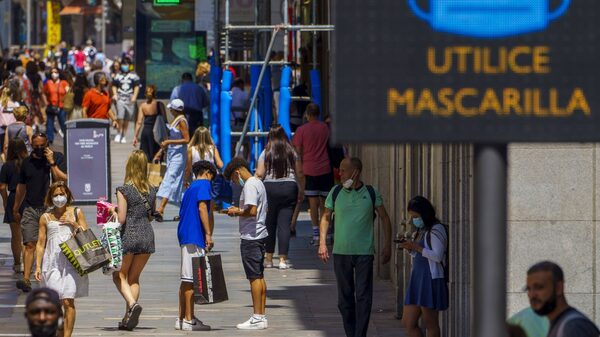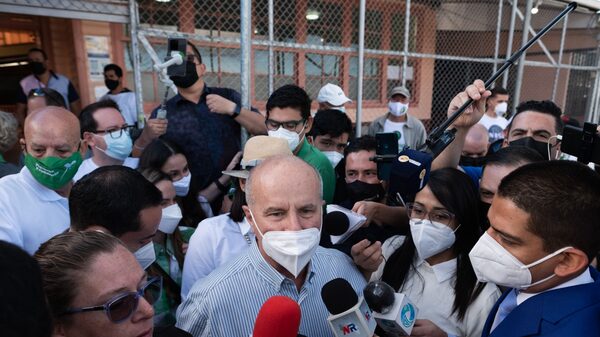Costa Rica is gearing up to welcome back more tourists as restrictions for incoming travelers are eased from this Friday, with visitors able to enter the country without the need to carry a ‘health pass’, while unvaccinated foreigners will no longer have to pay for medical insurance with Covid-19 coverage.
And although the use of face masks will continue to be mandatory, the government hopes that with the easing of restrictions the reactivation of the tourism industry can begin.
In addition to the above changes, all activities and events will be able to have 100% capacity without attendees requiring a QR code certifying a completed vaccination scheme against the virus, and which will likely further boost the sector’s recovery.
Tourism Minister Gustavo Alvarado talked to Bloomberg Línea about the tourism sector’s reactivation, what is still to be done, and the strategies adopted to allow a return to pre-pandemic levels of visitors, and the path that Costa Rica has taken to consolidate its sustainable tourism model.
Actions in favor of tourism are key for the country, with the sector representing around 6% of Costa Rica’s GDP, Alvarado says.
“We generate an important part of employment, over 300,000 employees are directly and indirectly related to tourism. In addition, our tourism model is dispersed throughout the country, so it brings development to all areas. Tourism is undoubtedly a driving force of our economy and a fundamental engine for economic improvement,” he says.
Welcoming Back Visitors
Alvarado says that, in 2021 the arrival of international passengers increased by 42.8% compared to 2020, with 1,347,055 tourist arrivals.
“That growth was much higher than what the World Tourism Organization had viewed as average growth across different countries, of between 20 to 30%.”
However, while acknowledging the positive figure, it is still far from the three million tourists that the country received in 2019, before the pandemic hit.
“In December we managed to have all the airlines that flew to Costa Rica before the pandemic operating flights to the country again, and that was fundamental because we were finally able to recover all the air connectivity with the countries from which tourists come, especially from Europe and the United States,” he says, adding that the challenge now is to increase the number of flights and therefore the number of seats and travelers to Costa Rica.
However, regarding the country’s forecasts for the full recovery of tourism, Alvarado says nothing is clearly defined, and that everything depends on the international situation, and the pandemic.
“As we all know, it depends a lot on the international situation. Right now we are in a complex situation due to the war in Ukraine, which in one way or another has an impact on tourism. We must also say that the pandemic is not over yet,” he says.
Alvarado’s expectation for this year is that Costa Rica will receive around two million tourists. “That is, we would lack one million more tourists to achieve the pre-pandemic average, so one would expect that for next year, 2023, we will equal the numbers we had in 2019″, he says, while acknowledging that the outlook and projections may change.
Extended High Season, Longer Stays
Despite the challenges that the pandemic brought, there are opportunities that in the long term could mean a new dynamic for tourism in Costa Rica, Alvarado says.
“I don’t like to compare pre-pandemic levels with those of today, because the dynamics have changed a lot,” he says.
The first change is that the high season has been quite positive, but that it has also been longer. “In the months of December, January and February, the average number of visitors arriving in Costa Rica exceeded 300,000 tourists. As such, we see that the high season has extended beyond the traditional months. The numbers for the month of March also seem to be quite positive, and for April we also foresee this trend growing”.
In addition, the opening of maritime borders for the arrivals of cruise ships and yachts to both the Atlantic and Pacific coasts of the country are factors that have had an impact on the extension of the high season, he says.
“We are optimistic. We are positive, I think we have been moving forward on the right path of reactivation. There is still a long way to go, but we are making positive progress.”
Sustainability, Pensioners, Digital Nomads and Women
Alvarado points out that Costa Rica’s current tourism model is not new and has been developing for decades.
“Although sustainability has become fashionable now, we have been working on this for more than 60 years, and it is not a sustainability that is only focused on environmental matters, but also on social matters,” he says.
He believes that the country has an advantage in this type of tourism over other nations that are just embarking on this vacation model, and which will also help Costa Rica’s economic reactivation post-pandemic.
“Now there is a greater awareness and respect for the environment, of engaging in tourism with your bubble of close people, focusing less on mass tourism and more on longer trips, and in that I think we are ahead.”
He also emphasized that, unlike other countries, Costa Rica has an internationally recognized tourism sustainability certificate, which has existed for more than 20 years and which recognizes companies in the sector that take actions in pursuit of environmental and social sustainability.
For Alvarado, it is key that Costa Rica does not seek to cater to mass tourism, but rather to travelers who travel throughout the country on longer stays.
“The country has one of the longest average stays by tourists. Before the pandemic, the average stay was approximately 12 days, which is quite a lot for a relatively small country of 54,000 square kilometers and which, for example, fits into Colombia 22 times,” he points out.
The government now expects tourists to opt for more and more of these stays, and is pushing for regulations to achieve this.
“In the midst of the pandemic, legislation was passed that adjusts to the new reality,” Alvarado says.
He referred to the ‘digital nomads’ law, with which the government seeks to attract that traveler segment to the country.
“This will be an international trend,” he says, explaining that the objective of the law is to encourage long-stay visits to the country and increase the spending of foreign currency.
The law allows travelers to stay for up to one year in the country with a visa that can be extended for an additional year under a non-resident migratory category. In addition, it grants travelers a benefit of total exemption of the tax on profits and on the import of basic computer and telecommunications equipment necessary for their work.
The law also allows them to drive in Costa Rica, as long as they have a valid license in their country of origin.
The idea, Alvarado says, is that digital nomads will contribute to the recovery of tourism through their payment for lodging, food, car rental, tours, and medical services, among others.
However, the law has yet to come into effect, despite the fact that it was signed on July 13, 2021 by President Carlos Alvarado. In principle, the executive had a term of two months to issue the regulation, but eight months later it has still not been published, and the delay worries those who hope to benefit from its implementation.
Óscar Villalobos, executive director of the Inter-institutional Commission of Marinas and Tourist Berths, explained to Costa Rican newspaper El Financiero that the regulations are expected to be ready and signed before the change of government. The second round of presidential elections take place on Sunday April 3.
Alvarado also highlighted a new law to promote the filming of movies in Costa Rica, and a law facilitating pensioners’ retirement in the country, a segment that has been key for the country in recent years and which the government wants to grow.
In addition, the number of women who travel alone is increasing, and which is also a niche market, and which the country is seeking to encourage through the so-called Sofia network program, which offers courses in conjunction with the International Women’s Institute, the Ministry of Public Security and the Costa Rican Tourism Institute on prevention, care and education on how to provide safe scenarios for women traveling alone.
“This program has only been in place for a few months, but I think we are taking an important step as a destination that will undoubtedly grow over time,” Alvarado says, emphasizing that the country’s tourism policies do not change with governments, which helps the continuity and growth of the sector.





